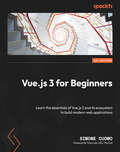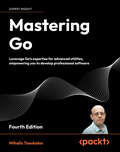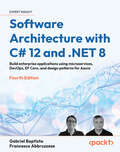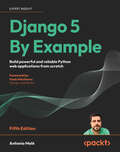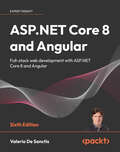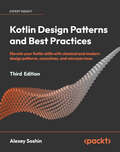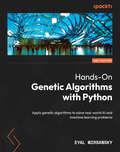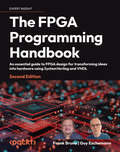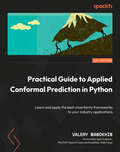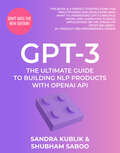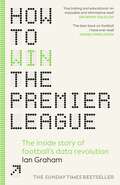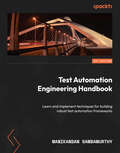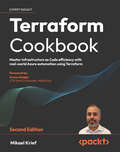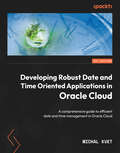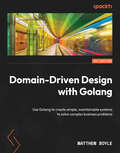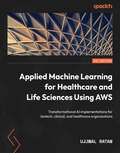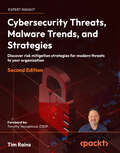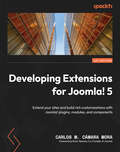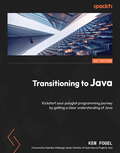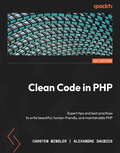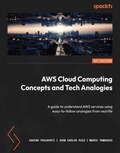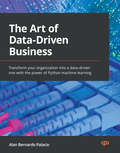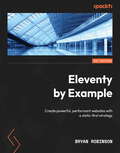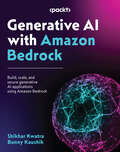- Table View
- List View
Vue.js 3 for Beginners: Learn the essentials of Vue.js 3 and its ecosystem to build modern web applications
by Simone CuomoGain proficiency in Vue.js 3 and its core libraries, including Pinia, Vue Router, and Vitest, by developing a social media web application with detailed, hands-on instructionsKey FeaturesDiscover best practices for building scalable and performant Vue.js applicationsLearn the basics of component-based architectureFamiliarize yourself with Vue.js core libraries and ecosystemPurchase of the print or Kindle book includes a free PDF eBookBook DescriptionDiscover why Vue.js is a must-learn JavaScript framework for aspiring developers. If you’re a beginner fascinated by Vue.js and its potential, then this book will show you how the progressive and versatile framework can help you build performant applications. Written by an accomplished software architect with over 12 years of experience, Vue.js for Beginners provides a solid foundation in Vue.js and guides you at every step to create a robust social media application, component by component. Starting with a clean canvas using plain HTML and CSS, you’ll learn new topics to build your application incrementally. Beyond the core features, you’ll explore crucial parts of the Vue.js ecosystem, such as state management with Pinia, routing with Vue Router, and testing with Vitest, and Cypress. The structured GitHub repository ensures a smooth transition from one chapter to the next, offering valuable insights into advanced topics, techniques, and recourses. This book is designed to serve as a practical reference guide, allowing you to quickly revisit specific topics when needed. By the end of the book, you’ll have built a strong understanding of Vue.js and be ready to build simple applications effortlessly.What you will learnGain practical knowledge of the Vue.js frameworkDeepen your understanding of Pinia, Vue Router, validation libraries, and their integration with Vue.js applicationsExplore the core concepts of Vue.js, including components, directives, and data bindingCreate scalable, maintainable applications from scratchBuild applications using the script setup and the Composition APIDebug your applications with the Vue debugger toolWho this book is forVue.js for Beginners is for aspiring web developers, students, hobbyists, or anyone who wants to learn Vue.js from scratch and is eager to foray into front-end development using this modern and popular framework. Basic knowledge of HTML, CSS, and JavaScript is required to fully grasp the content of this Vue.js book.
Mastering Go: Leverage Go's expertise for advanced utilities, empowering you to develop professional software
by Mihalis TsoukalosDive into the core of Go programming and cover advanced topics like generics, concurrency, web services, and cutting-edge testing techniques in this comprehensive fourth edition.Key FeaturesFully updated with coverage of web services, TCP/IP, REST APIs, Go Generics, and Fuzzy TestingApply your new knowledge to real-world exercises, building high-performance servers and robust command-line utilities, to deepen your learningGain clarity on what makes Go different, understand its nuances and features for smoother Go developmentBook DescriptionMastering Go, now in its fourth edition, remains the go-to resource for real-world Go development. This comprehensive guide delves into advanced Go concepts, including RESTful servers, and Go memory management. This edition brings new chapters on Go Generics and fuzzy Testing, and an enriched exploration of efficiency and performance. As you work your way through the chapters, you will gain confidence and a deep understanding of advanced Go topics, including concurrency and the operation of the Garbage Collector, using Go with Docker, writing powerful command-line utilities, working with JavaScript Object Notation (JSON) data, and interacting with databases. You will be engaged in real-world exercises, build network servers, and develop robust command-line utilities. With in-depth chapters on RESTful services, the WebSocket protocol, and Go internals, you are going to master Go's nuances, optimization, and observability. You will also elevate your skills in efficiency, performance, and advanced testing. With the help of Mastering Go, you will become an expert Go programmer by building Go systems and implementing advanced Go techniques in your projects.What you will learnLearn Go data types, error handling, constants, pointers, and array and slice manipulations through practical exercisesCreate generic functions, define data types, explore constraints, and grasp interfaces and reflectionsGrasp advanced concepts like packages, modules, functions, and database interactionCreate concurrent RESTful servers, and build TCP/IP clients and serversLearn testing, profiling, and efficient coding for high-performance applicationsDevelop an SQLite package, explore Docker integration, and embrace workspacesWho this book is forMastering Go is written primarily for Go programmers who have some experience with the language and want to become expert practitioners. You will need to know the basics of computer programming before you get started with this book, but beyond that, anyone can sink their teeth into it.
Software Architecture with C# 12 and .NET 8: Build enterprise applications using microservices, DevOps, EF Core, and design patterns for Azure
by Gabriel Baptista Francesco AbbruzzeseA book for the aspiring .NET software architect – design scalable and high-performance enterprise solutions using the latest features of C# 12 and .NET 8 Purchase of the print or Kindle book includes a free PDF eBookKey FeaturesGet introduced to software architecture fundamentals and begin applying them in .NETExplore the main technologies used by software architects and choose the best ones for your needsMaster new developments in .NET with the help of a practical case study that looks at software architecture for a travel agencyBook DescriptionSoftware Architecture with C# 12 and .NET 8 puts high-level design theory to work in a .NET context, teaching you the key skills, technologies, and best practices required to become an effective .NET software architect. This fourth edition puts emphasis on a case study that will bring your skills to life. You’ll learn how to choose between different architectures and technologies at each level of the stack. You’ll take an even closer look at Blazor and explore OpenTelemetry for observability, as well as a more practical dive into preparing .NET microservices for Kubernetes integration. Divided into three parts, this book starts with the fundamentals of software architecture, covering C# best practices, software domains, design patterns, DevOps principles for CI/CD, and more. The second part focuses on the technologies, from choosing data storage in the cloud to implementing frontend microservices and working with Serverless. You’ll learn about the main communication technologies used in microservices, such as REST API, gRPC, Azure Service Bus, and RabbitMQ. The final part takes you through a real-world case study where you’ll create software architecture for a travel agency. By the end of this book, you will be able to transform user requirements into technical needs and deliver highly scalable enterprise software architectures.What you will learnProgram and maintain Azure DevOps and explore GitHub ProjectsManage software requirements to design functional and non-functional needsApply architectural approaches such as layered architecture and domain-driven designMake effective choices between cloud-based and data storage solutionsImplement resilient frontend microservices, worker microservices, and distributed transactionsUnderstand when to use test-driven development (TDD) and alternative approachesChoose the best option for cloud development, from IaaS to ServerlessWho this book is forThis book is for engineers and senior software developers aspiring to become architects or looking to build enterprise applications with the .NET stack. Basic familiarity with C# and .NET is required to get the most out of this software architecture book.
Django 5 By Example: Build powerful and reliable Python web applications from scratch
by Antonio MeléBuild four real-world Django apps and learn Django by doing. Create fully functional web applications with authentication, content management systems, payment processing, REST APIs, and more! Purchase of the print or Kindle book includes a free eBook in PDF format.Key FeaturesUpdated with Django 5 features, detailed app planning, improved tooling, and GPT prompts for extending projectsLearn Django essentials, including models, ORM, views, templates, URLs, forms, authentication, signals, and middleware Integrate JavaScript, PostgreSQL, Redis, Celery, Docker, and Memcached into your applicationsBook DescriptionIf you want to learn Django by doing, this book is for you. Django 5 By Example is the fifth edition of the best-selling franchise that helps you build real-world web apps. This book will walk you through planning and creation, solving common problems, and implementing best practices using a step-by-step approach. You’ll cover a wide range of web application development topics through four different projects: a blog application, a social website, an e-commerce application, and an e-learning platform. Pick up what’s new in Django 5 as you build end-to-end Python web apps, follow detailed project plans, and understand the hows and whys of Django. This is a practical and approachable book that will have you creating web apps quickly.What you will learnUse different modules of the Django framework to solve specific problemsIntegrate third-party Django applications into your projectBuild complex web applications using Redis, Postgres, Celery/RabbitMQ, and MemcachedSet up a production environment for your projects with Docker ComposeBuild a RESTful API with Django Rest Framework (DRF)Implement advanced functionalities, such as full-text search engines, user activity streams, payment gateways, and recommendation enginesBuild real-time asynchronous (ASGI) apps with Django Channels and WebSocketsWho this book is forThis book is for readers with basic Python programming knowledge and programmers transitioning from other web frameworks who wish to learn Django by doing. If you already use Django, or have in the past, and want to learn best practices and integrate other technologies to scale your applications, then this book is for you too. This book will help you master the most relevant areas of the framework by building practical projects from scratch. Some previous knowledge of HTML and JavaScript is assumed.
ASP.NET Core 8 and Angular: Full-stack web development with ASP.NET Core 8 and Angular
by Valerio De SanctisBuild robust, scalable web applications using ASP.NET Core 8, Angular 17, and Entity Framework Core Purchase of the print or Kindle book includes a free PDF eBookKey FeaturesCombine ASP.NET Core and Angular to build highly versatile web applicationsCreate a production-ready Single-Page Application (SPA) or Progressive Web Application (PWA)Adopt a full-stack approach to handle data management, API documentation, Web APIs, end-to-end testing, security, and deploymentBook DescriptionIf you want to learn how to use ASP.NET Core with Angular effectively, this hands-on guide is for you. Improve the way you create, debug, and deploy web applications while keeping up to date with the latest developments in .NET 8 and modern Angular, including .NET Minimal APIs and the new Angular standalone API defaults. You’ll begin by setting up SQL Server 2022 and building a data model with Entity Framework Core. You’ll progress to fetching and displaying data, handling user input with Angular reactive forms, and implementing front-end and back-end validators for maximum effect. After that, you will perform advanced debugging and explore unit testing features with xUnit for .NET, and Jasmine and Karma for Angular. You’ll use Identity API endpoints in ASP.NET Core and functional route guards in Angular to add authentication and authorization to your apps. Finally, you’ll learn how to deploy to Windows, Linux, and Azure. By the end of this book, you will understand how to tie together the front-end and back-end to build and deploy secure and robust web applications.What you will learnExplore the new Angular and ASP.NET Core template with Visual Studio 2022Use modern interfaces and patterns such as the HTML5 pushState API, webhooks, and UI data bindingsAdd real-time capabilities to Angular apps with SignalR and gRPCImplement authentication and authorization using JWTsPerform DBMS structured logging using providers such as SeriLogConvert a standard web application to a progressive web application (PWA)Deploy an Angular app to Azure Static Web AppsAdd GraphQL support to back-end and front-end using HotChocolate and Apollo AngularWho this book is forThis book is for developers who have some familiarity with ASP.NET Core and Angular and want to learn how to use them effectively together.
Kotlin Design Patterns and Best Practices: Elevate your Kotlin skills with classical and modern design patterns, coroutines, and microservices
by Alexey SoshinDive deep into Kotlin design patterns, explore idiomatic functional programming, and master microservices with frameworks like Arrow, Ktor, and Vert.x.Key FeaturesStart from basic Kotlin syntax and go all the way to advanced topics like Coroutines and structural concurrencyLearn how to select and implement the right design pattern for your next Kotlin projectGet to grips with concurrent and reactive microservices with Ktor and Vert.xBook DescriptionFor developers who are working with design patterns in Kotlin, this practical guide offers an opportunity to put their knowledge into practice. The book covers classical and modern design patterns, and provides a hands-on approach to implementation, along with associated methodologies. The third edition stays current with Kotlin updates, spanning from version 1.6 onwards, and offers in-depth insights into topics like structured concurrency and context receivers. The book starts by introducing essential Kotlin syntax and the significance of design patterns, covering classic Creational, Structural, and Behavioral patterns. It then progresses to explore functional programming, Reactive, and Concurrent patterns, including detailed discussions on coroutines and structured concurrency. As you navigate through these advanced concepts, you'll enhance your Kotlin coding skills. The book also delves into the latest architectural trends, focusing on microservices design patterns and aiding your decision-making process when choosing between architectures. By the end of the book, you will have a solid grasp of these advanced concepts and be able to apply them in your own projects.What you will learnUtilize functional programming and coroutines with the Arrow frameworkUse classical design patterns in the Kotlin programming languageScale your applications with reactive and concurrent design patternsDiscover best practices in Kotlin and explore its new featuresApply the key principles of functional programming to KotlinFind out how to write idiomatic Kotlin code and learn which patterns to avoidHarness the power of Kotlin to design concurrent and reliable systems with easeCreate an effective microservice with Kotlin and the Ktor frameworkWho this book is forThis book is for developers who want to apply design patterns they've learned from other languages in Kotlin and build reliable, scalable, and maintainable applications. You'll need a good grasp on at least one programming language before you get started with this book. Familiarity with classical design patterns from your language of choice would be helpful, but you'll still be able to follow along if you code in other languages
Hands-On Genetic Algorithms with Python: Apply genetic algorithms to solve real-world AI and machine learning problems
by Eyal WirsanskyExplore the ever-growing world of genetic algorithms to build and enhance AI applications involving search, optimization, machine learning, deep learning, NLP, and XAI using Python librariesKey FeaturesLearn how to implement genetic algorithms using Python libraries DEAP, scikit-learn, and NumPyTake advantage of cloud computing technology to increase the performance of your solutionsDiscover bio-inspired algorithms such as particle swarm optimization (PSO) and NEATPurchase of the print or Kindle book includes a free PDF eBookBook DescriptionWritten by Eyal Wirsansky, a senior data scientist and AI researcher with over 25 years of experience and a research background in genetic algorithms and neural networks, Hands-On Genetic Algorithms with Python offers expert insights and practical knowledge to master genetic algorithms. After an introduction to genetic algorithms and their principles of operation, you’ll find out how they differ from traditional algorithms and the types of problems they can solve, followed by applying them to search and optimization tasks such as planning, scheduling, gaming, and analytics. As you progress, you’ll delve into explainable AI and apply genetic algorithms to AI to improve machine learning and deep learning models, as well as tackle reinforcement learning and NLP tasks. This updated second edition further expands on applying genetic algorithms to NLP and XAI and speeding up genetic algorithms with concurrency and cloud computing. You’ll also get to grips with the NEAT algorithm. The book concludes with an image reconstruction project and other related technologies for future applications. By the end of this book, you’ll have gained hands-on experience in applying genetic algorithms across a variety of fields, with emphasis on artificial intelligence with Python.What you will learnUse genetic algorithms to solve planning, scheduling, gaming, and analytics problemsCreate reinforcement learning, NLP, and explainable AI applicationsEnhance the performance of ML models and optimize deep learning architectureDeploy genetic algorithms using client-server architectures, enhancing scalability and computational efficiencyExplore how images can be reconstructed using a set of semi-transparent shapesDelve into topics like elitism, niching, and multiplicity in genetic solutions to enhance optimization strategies and solution diversityWho this book is forIf you’re a data scientist, software developer, AI enthusiast who wants to break into the world of genetic algorithms and apply them to real-world, intelligent applications as quickly as possible, this book is for you. Working knowledge of the Python programming language is required to get started with this book.
The FPGA Programming Handbook: An essential guide to FPGA design for transforming ideas into hardware using SystemVerilog and VHDL
by Frank Bruno Guy EschemannDevelop solid FPGA programming skills in SystemVerilog and VHDL by crafting practical projects – VGA controller, microprocessor, calculator, keyboard – and amplify your know-how with insider industry knowledge, all in one handbook. Purchase of the print or Kindle book includes a free eBook in PDF formatKey FeaturesExplore a wide range of FPGA applications, grasp their versatility, and master Xilinx FPGA tool flowMaster the intricacies of SystemVerilog and VHDL to develop robust and efficient hardware circuitsRefine skills with CPU, VGA, and calculator projects for practical expertise in real-world applicationsBook DescriptionIn today's tech-driven world, Field Programmable Gate Arrays (FPGAs) are foundation of many modern systems. Transforming ideas into reality demands a deep dive into FPGA architecture, tools, and design principles. This FPGA book is your essential companion to FPGA development with SystemVerilog and VHDL, tailored for both beginners and those looking to expand their knowledge. In this edition, you will gain versatility in FPGA design, opening doors to diverse opportunities and projects in the field. Go beyond theory with structured, hands-on projects, starting from simple LED control and progressing to advanced microcontroller applications, highly sought after in today's FPGA job market. You will go from basic Boolean logic circuits to a resource-optimized calculator, showcasing your hardware design prowess. Elevate your knowledge by designing a VGA controller, demonstrating your ability to synthesize complex hardware systems. Use this handbook as your FPGA development guide, mastering intricacies, igniting creativity, and emerging with the expertise to craft hardware circuits using SystemVerilog and VHDL. This isn't just another technical manual; it's your exhilarating journey to master both theory and practice, accelerating your FPGA design skills to soaring new heights. Grab your copy today and start this exciting journey!What you will learnUnderstand the FPGA architecture and its implementationGet to grips with writing SystemVerilog and VHDL RTLMake FPGA projects using SystemVerilog and VHDL programmingWork with computer math basics, parallelism, and pipeliningExplore the advanced topics of AXI and keyboard interfacing with PS/2Discover how you can implement a VGA interface in your projectsExplore the PMOD connectors-SPI and UART, using Nexys A7 boardImplement an embedded microcontroller in the FPGAWho this book is forThis FPGA design book is for embedded system developers, engineers, and programmers who want to learn FPGA design using SystemVerilog or VHDL programming from scratch. FPGA designers looking to gain hands-on experience with real-world projects will also find this book useful. Whether you are new to FPGA development or seeking to enhance your skills, this book provides a solid foundation and practical experience in FPGA design.
Practical Guide to Applied Conformal Prediction in Python: Learn and apply the best uncertainty frameworks to your industry applications
by Valery ManokhinElevate your machine learning skills using the Conformal Prediction framework for uncertainty quantification. Dive into unique strategies, overcome real-world challenges, and become confident and precise with forecasting.Key FeaturesMaster Conformal Prediction, a fast-growing ML framework, with Python applicationsExplore cutting-edge methods to measure and manage uncertainty in industry applicationsUnderstand how Conformal Prediction differs from traditional machine learningBook DescriptionIn the rapidly evolving landscape of machine learning, the ability to accurately quantify uncertainty is pivotal. The book addresses this need by offering an in-depth exploration of Conformal Prediction, a cutting-edge framework to manage uncertainty in various ML applications. Learn how Conformal Prediction excels in calibrating classification models, produces well-calibrated prediction intervals for regression, and resolves challenges in time series forecasting and imbalanced data. Discover specialised applications of conformal prediction in cutting-edge domains like computer vision and NLP. Each chapter delves into specific aspects, offering hands-on insights and best practices for enhancing prediction reliability. The book concludes with a focus on multi-class classification nuances, providing expert-level proficiency to seamlessly integrate Conformal Prediction into diverse industries. With practical examples in Python using real-world datasets, expert insights, and open-source library applications, you will gain a solid understanding of this modern framework for uncertainty quantification. By the end of this book, you will be able to master Conformal Prediction in Python with a blend of theory and practical application, enabling you to confidently apply this powerful framework to quantify uncertainty in diverse fields.What you will learnThe fundamental concepts and principles of conformal predictionLearn how conformal prediction differs from traditional ML methodsApply real-world examples to your own industry applicationsExplore advanced topics - imbalanced data and multi-class CPDive into the details of the conformal prediction frameworkBoost your career as a data scientist, ML engineer, or researcherLearn to apply conformal prediction to forecasting and NLPWho this book is forIdeal for readers with a basic understanding of machine learning concepts and Python programming, this book caters to data scientists, ML engineers, academics, and anyone keen on advancing their skills in uncertainty quantification in ML.
GPT-3: The Ultimate Guide To Building NLP Products With OpenAI API
by Sandra Kublik Shubham SabooGPT-3: The Ultimate Guide To Building NLP Products With OpenAI API is a comprehensive book on the Generative Pre-trained Transformer 3 AI language model, covering its significance, capabilities, and application in creating innovative NLP Products.Key FeaturesExploration of GPT-3: The book explores GPT-3, a powerful language model, and its capabilitiesBusiness applications: The book provides practical knowledge on using GPT-3 to create new business productsExamination of AI trends: The book examines the impact of GPT-3 on emerging creator economy and trends like no-code & AGIBook DescriptionGPT-3 has made creating AI apps simpler than ever. This book provides a comprehensive guide on how to utilize the OpenAI API with ease. It explores imaginative methods of utilizing this tool for your specific needs and showcases successful businesses that have been established through its use.The book is divided into two sections, with the first focusing on the fundamentals of the OpenAI API. The second part examines the dynamic and thriving environment that has arisen around GPT-3.Chapter 1 sets the stage with background information and defining key terms. Chapter 2 goes in-depth into the API, breaking it down into its essential components, explaining their functions and offering best practices. Chapter 3, you will build your first app with GPT-3.Chapter 4 features interviews with the founders of successful GPT-3-based products, who share challenges and insights gained. Chapter 5 examines the perspective of enterprises on GPT-3 and its potential for adoption. The problematic consequences of widespread GPT-3 adoption, such as misapplication and bias, are addressed along with efforts to resolve these issues in Chapter 6. Finally, Chapter 7 delves into the future by exploring the most exciting trends and possibilities as GPT-3 becomes increasingly integrated into the commercial ecosystem.What you will learnLearn the essential components of the OpenAI API along with the best practicesBuild and deploy your first GPT-3 powered applicationLearn from the journeys of industry leaders, startup founders who have built and deployed GPT-3 based products at scaleLook at how enterprises view GPT-3 and its potential for adoption for scalable solutionsNavigating the Consequences of GPT-3 adoption and efforts to resolve themExplore the exciting trends and possibilities of combining models with GPT-3 with No codeWho this book is forThis book caters to individuals from diverse backgrounds, not just technical experts. It should be useful to you if you are:A data expert seeking to improve your AI expertiseAn entrepreneur looking to revolutionize the AI industryA business leader seeking to enhance your AI knowledge and apply it to informed decision makingA content creator in the language domain looking to utilize GPT-3's language abilities for creative and imaginative projectsAnyone with an AI idea that was previously deemed technically unfeasible or too costly to execute
How to Win the Premier League: The Sunday Times Bestselling Inside Story of Football's Data Revolution
by Ian GrahamTHE SUNDAY TIMES BESTSELLER'The best book on football I have ever read' Daniel Finkelstein'Fascinating and educational. An enjoyable and informative read' Sir Kenny Dalglish'Deserves a place among the great modern books on football' Sam Wallace, chief football writer, Telegraph______________________________The insider account of the data revolution that has swept through the modern football world written by one of its key architects, Ian Graham.Between 2012 and 2023, Ian Graham worked as Liverpool FC's Director of Research. His tenure coincided with the club’s greatest period of success since the 1980s, including winning the Premier League in 2020 – Liverpool’s first league title after an agonising three decades.Here for the first time, Graham reveals the fascinating data that informed some of the club’s most pivotal moments of the past decade, from the appointment of Jurgen Klopp as manager in 2015 to the signing of Mohamed Salah in 2017. Along the way, he shares groundbreaking insight into the modern game, including how a season largely played behind closed doors transformed our understanding of home team advantage, or why the GOAT (greatest of all time) might not be who you think. And, in a game that is increasingly dominated by an elite few, Graham charts a path for the future where a data-savvy competitor will always find the edge.______________________________'A fascinating, witty and remarkably insightful account of Liverpool's reinvention and a clear-eyed, detailed explanation of the inner workings of modern football. Nobody is better qualified to tell either of those stories than Ian Graham, who stands as one of the most (quietly) significant figures in the recent history of the club and the sport' Rory Smith, author of Expected Goals and Chief Soccer Correspondent, New York Times'Never before has the data revolution in football been described so well from the inside.' Christoph Biermann, author of Football Hackers‘How to Win the Premier League gives you three books for the price of one: a book about all of the silly inefficiencies plaguing European football, a book about what it's like to be empowered to use outside-the-box thinking to help turn your boyhood club into the best team in the world, and a book about how football actually works. If he really wanted to, Ian could easily put me out of a job.’Ryan O’Hanlon, author of Net Gains and staff writer ESPN*A Sunday Times bestseller August 2024
Test Automation Engineering Handbook: Learn and implement techniques for building robust test automation frameworks
by Manikandan SambamurthyUnderstand test automation and implement it in Web, Mobile, and APIs effectivelyKey FeaturesLearn how to automate your tests with the help of practical examplesUnderstand how to bridge the gap between testing and test automationExplore test automation strategies for different platformsBook DescriptionThis book helps you build a better understanding of test automation and aids in bridging the gap between testing and test automation.The book has been divided into three sections with the first section focusing on preparing you for testing and test automation fundamentals. By the end of this section, you'll have an understanding of some common automation terms, definitions, and roles. The second section covers the practical implementation of test automation for mobile, web, API and performance. The third section will help you understand how test automation works with CI/CD, and explore the common issues and pitfalls when executing test automation.By the end of this book, you'll have a better understanding of automation, addressing the common pain points and best practices around test automation.What you will learnGain a solid understanding of test automationUnderstand how automation fits into a test strategyExplore essential design patterns for test automationDesign and implement highly reliable automated testsUnderstand issues and pitfalls when executing test automationDiscover the commonly used test automation tools/frameworksWho this book is forThis book is for manual testers who want to enter the field of test automation and developers who want to learn more about test automation.
Terraform Cookbook: Master Infrastructure as Code efficiency with real-world Azure automation using Terraform
by Mikael KriefExplore how to provision, manage, and scale your infrastructure using Infrastructure as Code (IaC) with Terraform Purchase of the print or Kindle book includes a free PDF eBookKey FeaturesGet up and running with Terraform (v1+) CLI and automate infrastructure provisioningDiscover how to deploy Kubernetes resources with TerraformBecome a Terraform troubleshooting expert for streamlined infrastructure management and minimal downtimeBook DescriptionImagine effortlessly provisioning complex cloud infrastructure across various cloud platforms, all while ensuring robustness, reusability, and security. Introducing the Terraform Cookbook, Second Edition - your go-to guide for mastering Infrastructure as Code (IaC) effortlessly. This new edition is packed with real-world examples for provisioning robust Cloud infrastructure mainly across Azure but also with a dedicated chapter for AWS and GCP. You will delve into manual and automated testing with Terraform configurations, creating and managing a balanced, efficient, reusable infrastructure with Terraform modules. You will learn how to automate the deployment of Terraform configurations through continuous integration and continuous delivery (CI/CD), unleashing Terraform's full potential. New chapters have been added that describe the use of Terraform for Docker and Kubernetes, and explain how to test Terraform configurations using different tools to check code and security compliance. The book devotes an entire chapter to achieving proficiency in Terraform Cloud, covering troubleshooting strategies for common issues and offering resolutions to frequently encountered errors. Get the insider knowledge to boost productivity with Terraform - the indispensable guide for anyone adopting Infrastructure as Code solutions.What you will learnUse Terraform to build and run cloud and Kubernetes infrastructure using IaC best practicesAdapt the Terraform command line adapted to appropriate use casesAutomate the deployment of Terraform confi guration with CI/CDDiscover manipulation of the Terraform state by adding or removing resourcesExplore Terraform for Docker and Kubernetes deployment, advanced topics on GitOps practices, and Cloud Development Kit (CDK)Add and apply test code and compliance security in Terraform configurationDebug and troubleshoot common Terraform errorsWho this book is forThis book is for developers, operators, and DevOps engineers looking to improve their workflow and use Infrastructure as Code. If you find yourself spending too much time on manual infrastructure provisioning, struggling to manage complex deployments across environments, or facing unexpected downtime due to infrastructure issues then this book is meant for you. Experience with Microsoft Azure, Jenkins, shell scripting, and DevOps practices is required to get the most out of this Terraform book.
Developing Robust Date and Time Oriented Applications in Oracle Cloud: A comprehensive guide to efficient date and time management in Oracle Cloud
by Michal KvetCreate robust temporal solutions in Oracle Cloud and spread the solution worldwide by leveraging its regional properties and time zone synchronizationPurchase of the print or Kindle book includes a free PDF eBookKey FeaturesMigrate existing on-premises applications to the Oracle Cloud environment using data migration techniquesHandle date and time values efficiently using Oracle database's available data types and duration modeling principlesApply temporal database models in real-world systems to ensure robustness, security, and performanceBook DescriptionProper date and time management is critical for the development and reliability of Oracle Databases and cloud environments, which are among the most rapidly expanding technologies today. This knowledge can be applied to cloud technology, on premises, application development, and integration to emphasize regional settings, UTC coordination, or different time zones. This practical book focuses on code snippets and discusses the existing functionalities and limitations, along with covering data migration to the cloud by emphasizing the importance of proper date and time management. This book helps you understand the historical background and evolution of ANSI standards. You'll get to grips with data types, constructor principles, and existing functionalities, and focus on the limitations of regional parameters and time zones, which help in expanding business to other parts of the world. You'll also explore SQL injection threats, temporal database architecture, using Flashback Technology to reconstruct valid database images from the past, time zone management, and UTC synchronization across regions. By the end of this book, you'll be able to create and manage temporal systems, prevent SQL injection attacks, use existing functionalities and define your own robust solutions for date management, and apply time zone and region rules.What you will learnExplore the fundamentals and terms related to Oracle Cloud Infrastructure (OCI) and data migrationFollow core principles and date and time element management supervised by ANSI standardizationDiscover the limitations of existing functionalities and conversion methodsBuild robust and secure temporal solutions that are resistant to SQL injection threatsUnderstand time zone management and regional settings by focusing on regional and national conventions and approachesUse Flashback Technology to create temporal models in terms of historical and current statesWho this book is forThis book is for IT specialists, students, system developers, database administrators, and cloud integrators. With a hands-on approach, this book will help you to gain a comprehensive view of the issue of time processing and enable you to develop complex, robust applications that are usable and portable in any region.
Creators of Intelligence: Industry secrets from AI leaders that you can easily apply to advance your data science career
by John K. Thompson Dr. Alex AnticGet your hands on the secret recipe for a rewarding career in data science from 18 AI leadersPurchase of the print or Kindle book includes a free PDF eBookKey FeaturesGain access to insights and expertise from data science leaders shared in one-on-one interviewsGet pragmatic advice on how to become a successful data scientist and data science leaderReceive guidance to overcome common pitfalls and challenges and ensure your projects' successBook DescriptionA Gartner prediction in 2018 led to numerous articles stating that "85% of AI and machine learning projects fail to deliver.” Although it's unclear whether a mass extinction event occurred for AI implementations at the end of 2022, the question remains: how can I ensure that my project delivers value and doesn't become a statistic? The demand for data scientists has only grown since 2015, when they were dubbed the new “rock stars” of business. But how can you become a data science rock star? As a new senior data leader, how can you build and manage a productive team? And what is the path to becoming a chief data officer? Creators of Intelligence is a collection of in-depth, one-on-one interviews where Dr. Alex Antic, a recognized data science leader, explores the answers to these questions and more with some of the world's leading data science leaders and CDOs. Interviews with: Cortnie Abercrombie, Edward Santow, Kshira Saagar, Charles Martin, Petar Velickovic, Kathleen Maley, Kirk Borne, Nikolaj Van Omme, Jason Tamara Widjaja, Jon Whittle, Althea Davis, Igor Halperin, Christina Stathopoulos, Angshuman Ghosh, Maria Milosavljevic, Dr. Meri Rosich, Dat Tran, and Stephane Doyen.What you will learnFind out where to start with AI ethics and how to evolve from frameworks to practiceDiscover tips on building and managing a data science teamReceive advice for organizations seeking to build or mature a data science capabilityStop beating your head against a brick wall – pick the environment that'll support your successRead stories from successful data leaders as they reflect on the successes and failures in data strategy developmentUnderstand how business areas can best work with data science teams to drive business valueWho this book is forThis book is for a wide range of audience, from people working in the data science industry through to data science leaders and chief data officers. This book will also cater to senior business leaders interested in learning how data and analytics are used to support decision-making in different domains and sectors. Students contemplating a career in artificial intelligence (AI) and the broader data sector will also find this book useful, along with anyone developing and delivering university-level education, including undergraduate, postgraduate, and executive programs.
Domain-Driven Design with Golang: Use Golang to create simple, maintainable systems to solve complex business problems
by Matthew BoyleUnderstand the concept of Domain-driven design and build two DDD systems from scratch that can be showcased as part of your portfolioKey FeaturesExplore Domain-driven design as a timeless concept and learn how to apply it with GoBuild a domain-driven monolithic application and a microservice from scratchLeverage patterns to make systems scalable, resilient, and maintainableBook DescriptionDomain-driven design (DDD) is one of the most sought-after skills in the industry. This book provides you with step-by-step explanations of essential concepts and practical examples that will see you introducing DDD in your Go projects in no time. Domain-Driven Design with Golang starts by helping you gain a basic understanding of DDD, and then covers all the important patterns, such as bounded context, ubiquitous language, and aggregates. The latter half of the book deals with the real-world implementation of DDD patterns and teaches you how to build two systems while applying DDD principles, which will be a valuable addition to your portfolio. Finally, you'll find out how to build a microservice, along with learning how DDD-based microservices can be part of a greater distributed system. Although the focus of this book is Golang, by the end of this book you'll be able to confidently use DDD patterns outside of Go and apply them to other languages and even distributed systems.What you will learnGet to grips with domains and the evolution of Domain-driven designWork with stakeholders to manage complex business needsGain a clear understanding of bounded context, services, and value objectsGet up and running with aggregates, factories, repositories, and servicesFind out how to apply DDD to monolithic applications and microservicesDiscover how to implement DDD patterns on distributed systemsUnderstand how Test-driven development and Behavior-driven development can work with DDDWho this book is forThis book is for intermediate-level Go developers who are looking to ensure that they not only write maintainable code, but also deliver great business value. If you have a basic understanding of Go and are interested in learning about Domain-driven design, or you've explored Domain-driven design before but never in the context of Go, then this book will be helpful.
Applied Machine Learning for Healthcare and Life Sciences Using AWS: Transformational AI implementations for biotech, clinical, and healthcare organizations
by Ujjwal RatanBuild real-world artificial intelligence apps on AWS to overcome challenges faced by healthcare providers and payers, as well as pharmaceutical, life sciences research, and commercial organizationsKey FeaturesLearn about healthcare industry challenges and how machine learning can solve themExplore AWS machine learning services and their applications in healthcare and life sciencesDiscover practical coding instructions to implement machine learning for healthcare and life sciencesBook DescriptionWhile machine learning is not new, it's only now that we are beginning to uncover its true potential in the healthcare and life sciences industry. The availability of real-world datasets and access to better compute resources have helped researchers invent applications that utilize known AI techniques in every segment of this industry, such as providers, payers, drug discovery, and genomics. This book starts by summarizing the introductory concepts of machine learning and AWS machine learning services. You'll then go through chapters dedicated to each segment of the healthcare and life sciences industry. Each of these chapters has three key purposes -- First, to introduce each segment of the industry, its challenges, and the applications of machine learning relevant to that segment. Second, to help you get to grips with the features of the services available in the AWS machine learning stack like Amazon SageMaker and Amazon Comprehend Medical. Third, to enable you to apply your new skills to create an ML-driven solution to solve problems particular to that segment. The concluding chapters outline future industry trends and applications. By the end of this book, you'll be aware of key challenges faced in applying AI to healthcare and life sciences industry and learn how to address those challenges with confidence.What you will learnExplore the healthcare and life sciences industryFind out about the key applications of AI in different industry segmentsApply AI to medical images, clinical notes, and patient dataDiscover security, privacy, fairness, and explainability best practicesExplore the AWS ML stack and key AI services for the industryDevelop practical ML skills using code and AWS servicesDiscover all about industry regulatory requirementsWho this book is forThis book is specifically tailored toward technology decision-makers, data scientists, machine learning engineers, and anyone who works in the data engineering role in healthcare and life sciences organizations. Whether you want to apply machine learning to overcome common challenges in the healthcare and life science industry or are looking to understand the broader industry AI trends and landscape, this book is for you. This book is filled with hands-on examples for you to try as you learn about new AWS AI concepts.
Cybersecurity Threats, Malware Trends, and Strategies: Discover risk mitigation strategies for modern threats to your organization, 2nd Edition
by Tim Rains Timothy Youngblood CISSPImplement effective cybersecurity strategies to help you and your security team protect, detect, and respond to modern-day threatsPurchase of the print or Kindle book includes a free eBook in PDF format.Key FeaturesProtect your organization from cybersecurity threats with field-tested strategiesUnderstand threats such as exploits, malware, internet-based threats, and governmentsMeasure the effectiveness of your organization's current cybersecurity program against modern attackers' tacticsBook DescriptionTim Rains is Microsoft's former Global Chief Security Advisor and Amazon Web Services' former Global Security Leader for Worldwide Public Sector. He has spent the last two decades advising private and public sector organizations all over the world on cybersecurity strategies.Cybersecurity Threats, Malware Trends, and Strategies, Second Edition builds upon the success of the first edition that has helped so many aspiring CISOs, and cybersecurity professionals understand and develop effective data-driven cybersecurity strategies for their organizations. In this edition, you'll examine long-term trends in vulnerability disclosures and exploitation, regional differences in malware infections and the socio-economic factors that underpin them, and how ransomware evolved from an obscure threat to the most feared threat in cybersecurity. You'll also gain valuable insights into the roles that governments play in cybersecurity, including their role as threat actors, and how to mitigate government access to data. The book concludes with a deep dive into modern approaches to cybersecurity using the cloud.By the end of this book, you will have a better understanding of the threat landscape, how to recognize good Cyber Threat Intelligence, and how to measure the effectiveness of your organization's cybersecurity strategy.What you will learnDiscover enterprise cybersecurity strategies and the ingredients critical to their successImprove vulnerability management by reducing risks and costs for your organizationMitigate internet-based threats such as drive-by download attacks and malware distribution sitesLearn the roles that governments play in cybersecurity and how to mitigate government access to dataWeigh the pros and cons of popular cybersecurity strategies such as Zero Trust, the Intrusion Kill Chain, and othersImplement and then measure the outcome of a cybersecurity strategyDiscover how the cloud can provide better security and compliance capabilities than on-premises IT environmentsWho this book is forThis book is for anyone who is looking to implement or improve their organization's cybersecurity strategy. This includes Chief Information Security Officers (CISOs), Chief Security Officers (CSOs), compliance and audit professionals, security architects, and cybersecurity professionals. Basic knowledge of Information Technology (IT), software development principles, and cybersecurity concepts is assumed.
Developing Extensions for Joomla! 5: Extend your sites and build rich customizations with Joomla! plugins, modules, and components
by Carlos M. MoraHarness the full potential of Joomla! through this comprehensive take on Joomla! extensions from conception through to releaseKey FeaturesDiscover the complete cycle of extension development from conception to releaseLeverage built-in features such as categories, ACL, and custom fields to enrich your extensionsLearn how to build extensions that integrate with the Joomla! API and the new Joomla! CLIPurchase of the print or Kindle book includes a free PDF eBookBook DescriptionJoomla! 5 is a groundbreaking CMS that helps you take a significant leap into the world of content management systems. Joomla! 5 features a variety of impressive new features that align with current web standards and enable you to experience lightning-fast performance for optimal web page optimization, leverage the new code architecture, and tap into the WebService API, among others. This book takes you on a journey of extending Joomla's capabilities by developing your own extensions. The chapters not only explain the key concepts behind Joomla's architecture but also equip you with the latest techniques for crafting components and plugins. You’ll discover how to leverage existing features within Joomla! to empower your extensions and create tailored solutions. The book takes you from the initial stages of planning your extension development to a fully featured finished product. As you advance, you'll learn invaluable techniques for testing your extension, addressing common issues, and preparing it for publication. The concluding chapters of this comprehensive guide teach you how to test your extension for common issues, along with how to publish the extension for everyone to use. By the end of this book, you’ll have the confidence and skills to complete the cycle of extension development.What you will learnFind out how to plan the development of a new extension from scratchUnderstand the basic structure of a Joomla! extensionGet to grips with the Joomla! Forms systemUse Joomla! features effectively to enrich your extensionsDiscover how to add a WebService API to your extensionCreate a Joomla! CLI command for your extensionDevelop a Joomla! Child Template for your projectsTest your extensions before the releaseWho this book is forThis book is for Joomla! developers and web designers who want to extend the functionalities of Joomla! and find innovative ways to customize their content management systems, e-commerce websites, business websites, and more. Basic familiarity with Joomla! will help you get the most out of this book.
Transitioning to Java: Kickstart your polyglot programming journey by getting a clear understanding of Java
by Ken FogelDevelop your Java coding skills by exploring object-oriented methodologies, functional programming, software design patterns, and morePurchase of the print or Kindle book includes a free PDF eBookKey FeaturesGet started with programming in Java with this step-by-step guide for experienced programmersRe-enforce your knowledge of object-oriented methodologies applied in JavaDevelop the range of skills necessary for you to become a successful Java developerBook DescriptionThis comprehensive guide will help non-Java developers already using different languages transition from their current language to all things Java. The chapters are designed in a way that re-enforces a developer's existing knowledge of object-oriented methodologies as they apply to Java. This book has been divided into four sections, with each section touching upon different aspects that'll enable your effective transition. The first section helps you get to grips with the Java development environment and the Maven build tool for modern Java applications. In the second section, you'll learn about Java language fundamentals, along with exploring object-oriented programming (OOP) methodologies and functional programming and discovering how to implement software design patterns in Java. The third section shows you how to code in Java on different platforms and helps you get familiar with the challenges faced on these platforms. In the fourth section, you'll find out how you can manage and package your Java code. By the end of this Java programming book, you'll have learned the core concepts of Java that'll help you successfully transition from a different language to Java.What you will learnGain a solid understanding of the syntax in JavaExplore the object-oriented programming basics of the Java languageDiscover how to implement functions in JavaUnderstand which Java frameworks would be best for solving various problemsExplore creational, structural, and behavioral patterns in JavaGet to grips with server-side coding in JavaWho this book is forThis book is for anyone who is currently working with other programming languages and wishes to add Java to their skillset. Prior working experience as a developer using languages other than Java is expected, although no prior knowledge of Java is required.
Clean Code in PHP: Expert tips and best practices to write beautiful, human-friendly, and maintainable PHP
by Carsten Windler Alexandre DauboisPractical lessons, examples, and practices from PHP experts on how to take your PHP skills to a professional levelKey FeaturesEasily navigate to key clean code principles specific to PHP development with this hands-on guideLearn the how and why of writing clean code through practical examplesSkip the superfluous knowledge and grasp everything that's relevant to the real-world development environmentBook DescriptionPHP is a beginner-friendly language, but also one that is rife with complaints of bad code,;yet no clean code books are specific to PHP. Enter Clean Code in PHP. This book is a one-stop guide to learning the theory and best practices of clean code specific to real-world PHP app development environments.This PHP book is cleanly split to help you navigate through coding practices and theories to understand and adopt the nuances of the clean code paradigm. In addition to covering best practices, tooling for code quality, and PHP design patterns, this book also presents tips and techniques for working on large-scale PHP apps with a team and writing effective documentation for your PHP projects.By the end of this book, you'll be able to write human-friendly PHP code, which will fuel your PHP career growth and set you apart from the competition.What you will learnBuild a solid foundation in clean coding to craft human-readable codeUnderstand metrics to determine the quality of your codeGet to grips with the basics of automated testsImplement continuous integration for your PHP applicationsGet an overview of software design patterns to help you write reusable codeGain an understanding of coding guidelines and practices for working in teamsWho this book is forThis book is for early-career PHP developers who wish to avoid writing messy code by learning how to write understandable and maintainable code that sets them apart from rest. The book assumes familiarity with PHP coding and principles, but no knowledge of advanced principles will be necessary.
AWS Cloud Computing Concepts and Tech Analogies: A guide to understand AWS services using easy-to-follow analogies from real life
by Ashish Prajapati Juan Carlos Ruiz Marco TamassiaOvercome common issues and find answers to cloud-related questions through real enterprise scenarios, characters, and dialoguePurchase of the print or Kindle book includes a free PDF eBookKey FeaturesLearn cloud concepts from AWS certified trainers using common analogies from real lifeGet to grips with the most commonly used services in the AWS cloudUnderstand how your knowledge from classical on premises IT can be applied to the CloudBook DescriptionThis book makes understanding cloud computing easy by providing relatable examples that simplify the complex technology. By drawing parallels between cloud concepts and everyday scenarios, we will demystify cloud tech, and once you start to understand it, learning cloud computing will be more enjoyable. This book will help you learn about cloud computing in general and AWS specifically, as you follow the journey of TrendyCorp—a fictitious company gearing up to move from traditional IT to cloud computing. You'll shape your understanding of the cloud through scenarios of interactions between TrendyCorp's new hires, seasoned IT professionals, external consultants, and the board of directors engaged in modernizing their applications. These characters' discussions and actions are focused on learning about cloud services by drawing comparisons between the technology and examples taken from real life. Through this book, you'll realize that cloud computing concepts have more in common with your day-to-day scenarios and situations than you've ever imagined. This book offers a conversational and entertaining narrative that anyone working in IT and looking to understand how the cloud works will be able to follow. By the end of it, you'll have developed a clear and simplified perspective of cloud technologies.What you will learnImplement virtual servers in the cloudIdentify the best cloud storage options for a specific solutionExplore best practices for networking and databases in the cloudEnforce security with authentication and authorization in the cloudEffectively monitor applications in the cloudLeverage scalability and automation in the cloudGet the hang of decoupled and serverless architectureGrasp the fundamentals of containers and Blockchain in the cloudWho this book is forThis book is for anyone who wants to learn AWS cloud computing. It explains all the foundational concepts and mechanisms in detail. So basic knowledge of IT systems or terminologies (like server, storage, IP address, and web applications) is all that you need to get started with this book.
The Art of Data-Driven Business: Transform your organization into a data-driven one with the power of Python machine learning
by Alan Bernardo PalacioLearn how to make the right decisions for your business with the help of Python recipes and the expertise of data leadersKey FeaturesLearn and practice various clustering techniques to gather market insights Explore real-life use cases from the business world to contextualize your learningWork your way through practical recipes that will reinforce what you have learnedBook DescriptionOne of the most valuable contributions of data science is toward helping businesses make the right decisions. Understanding this complicated confluence of two disparate worlds, as well as a fiercely competitive market, calls for all the guidance you can get.The Art of Data-Driven Business is your invaluable guide to gaining a business-driven perspective, as well as leveraging the power of machine learning (ML) to guide decision-making in your business. This book provides a common ground of discussion for several profiles within a company.You'll begin by looking at how to use Python and its many libraries for machine learning. Experienced data scientists may want to skip this short introduction, but you'll soon get to the meat of the book and explore the many and varied ways ML with Python can be applied to the domain of business decisions through real-world business problems that you can tackle by yourself. As you advance, you'll gain practical insights into the value that ML can provide to your business, as well as the technical ability to apply a wide variety of tried-and-tested ML methods.By the end of this Python book, you'll have learned the value of basing your business decisions on data-driven methodologies and have developed the Python skills needed to apply what you've learned in the real world.What you will learnCreate effective dashboards with the seaborn libraryPredict whether a customer will cancel their subscription to a serviceAnalyze key pricing metrics with pandasRecommend the right products to your customersDetermine the costs and benefits of promotionsSegment your customers using clustering algorithmsWho this book is forThis book is for data scientists, machine learning engineers and developers, data engineers, and business decision makers who want to apply data science for business process optimization and develop the skills needed to implement data science projects in marketing, sales, pricing, customer success, ad tech, and more from a business perspective. Other professionals looking to explore how data science can be used to improve business operations, as well as individuals with technical skills who want to back their technical proposal with a strong business case will also find this book useful.
Eleventy by Example: Create powerful, performant websites with a static-first strategy
by Bryan RobinsonBuild faster static sites by leveraging CDN and creating custom tools and workflows with 5 real-world projectsPurchase of the print or Kindle book includes a free PDF eBookKey FeaturesLearn how to use and extend 11ty, one of the most flexible static site generators in the industry.Optimize your experience by customizing 11ty to suit various projects' needsCreate request-time experiences without recreating templates with 11ty ServerlessBook Description11ty is the dark horse of the Jamstack world, offering unparalleled flexibility and performance that gives it an edge against other static site generators such as Jekyll and Hugo. With it, developers can leverage the complete Node ecosystem and create blazing-fast, static-first websites that can be deployed from a content delivery network or a simple server. This book will teach you how to set up, customize, and make the most of 11ty in no time. Eleventy by Example helps you uncover everything you need to create your first 11ty website before diving into making more complex sites and extending 11ty's base functionality with custom short codes, plugins, and content types. Over the course of 5 interactive projects, you'll learn how to build basic websites, blogs, media sites, and static sites that will respond to user input without the need for a server. With these, you'll learn basic 11ty skills such as templates, collections, and data use, along with advanced skills such as plugin creation, image manipulation, working with a headless CMS, and the use of the powerful 11ty Serverless plugin. By the end of this book, you'll be well-equipped to leverage the capabilities of 11ty by implementing best practices and reusable techniques that can be applied across multiple projects, reducing the website launch time.What you will learnCreate a basic website with reusable templates and globally available dataBuild a blog using 11ty's collectionsSet up a photography site that uses the 11ty Image plugin to deploy properly sized imagesConnect a content management system to provide an enhanced editor and developer experienceModel an enhanced search experience with no dedicated server through serverless functions and 11ty ServerlessBoost productivity by creating custom 11ty tools and pluginsWho this book is forThis book is for anyone looking to build efficient websites while shipping less JavaScript to the client. Strong knowledge of HTML and CSS and beginner-level knowledge of JavaScript and the Node.js ecosystem, including querying APIs is a must.
Generative AI with Amazon Bedrock: Build, scale, and secure generative AI applications using Amazon Bedrock
by Bunny Kaushik Shikhar KwatraBecome proficient in Amazon Bedrock by taking a hands-on approach to building and scaling generative AI solutions that are robust, secure, and compliant with ethical standardsKey FeaturesLearn the foundations of Amazon Bedrock from experienced AWS Machine Learning Specialist ArchitectsMaster the core techniques to develop and deploy several AI applications at scaleGo beyond writing good prompting techniques and secure scalable frameworks by using advanced tips and tricksPurchase of the print or Kindle book includes a free PDF eBookBook DescriptionThe concept of generative artificial intelligence has garnered widespread interest, with industries looking to leverage it to innovate and solve business problems. Amazon Bedrock, along with LangChain, simplifies the building and scaling of generative AI applications without needing to manage the infrastructure. Generative AI with Amazon Bedrock takes a practical approach to enabling you to accelerate the development and integration of several generative AI use cases in a seamless manner. You’ll explore techniques such as prompt engineering, retrieval augmentation, fine-tuning generative models, and orchestrating tasks using agents. The chapters take you through real-world scenarios and use cases such as text generation and summarization, image and code generation, and the creation of virtual assistants. The latter part of the book shows you how to effectively monitor and ensure security and privacy in Amazon Bedrock. By the end of this book, you’ll have gained a solid understanding of building and scaling generative AI apps using Amazon Bedrock, along with various architecture patterns and security best practices that will help you solve business problems and drive innovation in your organization.What you will learnExplore the generative AI landscape and foundation models in Amazon BedrockFine-tune generative models to improve their performanceExplore several architecture patterns for different business use casesGain insights into ethical AI practices, model governance, and risk mitigation strategiesEnhance your skills in employing agents to develop intelligence and orchestrate tasksMonitor and understand metrics and Amazon Bedrock model responseExplore various industrial use cases and architectures to solve real-world business problems using RAGStay on top of architectural best practices and industry standardsWho this book is forThis book is for generalist application engineers, solution engineers and architects, technical managers, ML advocates, data engineers, and data scientists looking to either innovate within their organization or solve business use cases using generative AI. A basic understanding of AWS APIs and core AWS services for machine learning is expected.
